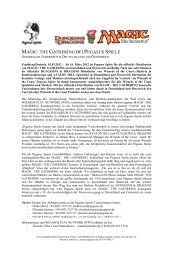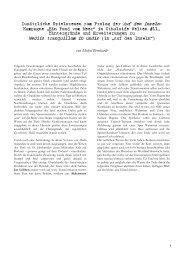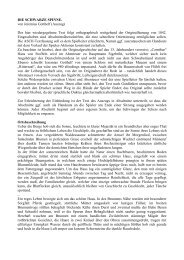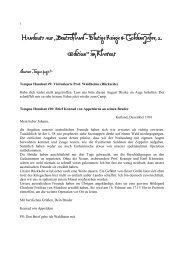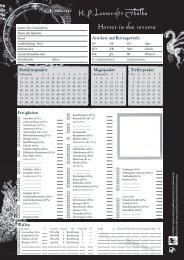Any old pot can become a bot! A Game for 3 to 5 robot designers
Any old pot can become a bot! A Game for 3 to 5 robot designers
Any old pot can become a bot! A Game for 3 to 5 robot designers
Create successful ePaper yourself
Turn your PDF publications into a flip-book with our unique Google optimized e-Paper software.
Have you ever wanted <strong>to</strong> have a free shot at building ro<strong>bot</strong>s<br />
with some useful and also some dodgy functions? Sounds<br />
difficult? Not at all! The main thing is that the <strong>bot</strong>s look<br />
funny and have some function – any function ... Make a<br />
name <strong>for</strong> yourself as the oddest designer of ro<strong>bot</strong>s, but<br />
also as a s<strong>to</strong>ne-c<strong>old</strong> merchant. This is your big break!<br />
Outline<br />
The game plays out over several turns. In each turn,<br />
you may per<strong>for</strong>m two actions. Most often, you will be<br />
acquiring new parts.<br />
Orders allocated <strong>to</strong> your workshops in<strong>for</strong>m you which<br />
types of ro<strong>bot</strong>s are currently in hot demand, and which<br />
components are manda<strong>to</strong>ry <strong>for</strong> inclusion in these designs.<br />
You win the game if you are the first designer <strong>to</strong> have<br />
fulfilled three orders, or if you have amassed the sum<br />
of 10,000 credits.<br />
<strong>Game</strong> Components<br />
1 market place (disc): this<br />
displays offer and demand<br />
<strong>for</strong> components on <strong>bot</strong>h the<br />
regular and the black market.<br />
16 order cards: these list the<br />
current demand <strong>for</strong> ro<strong>bot</strong>s.<br />
1 linen bag: this stands in <strong>for</strong> the<br />
scrap yard. Players may randomly<br />
collect components here, but<br />
manufacturing controllers and sa<strong>bot</strong>eurs<br />
also lurk here.<br />
5 garages: these are the players’<br />
workshops.<br />
100 bills in these denominations:<br />
25 x 100 credits, 25 x 200, 20 x 500,<br />
20 x 1,000, and 10 x 5,000 credits.<br />
<strong>Any</strong> <strong>old</strong> <strong>pot</strong> <strong>can</strong> <strong>become</strong> a <strong>bot</strong>!<br />
A <strong>Game</strong> <strong>for</strong> 3 <strong>to</strong> 5 ro<strong>bot</strong> <strong>designers</strong><br />
86 game counters: (components:<br />
12 heads, 10 sets of wheels,<br />
12 pincers, 6 suction cups,<br />
6 propellers, 6 plungers, 12 <strong>to</strong>rsos,<br />
10 switches; special counters:<br />
4 multi-functional components,<br />
4 manufacturing controls, 4 sa<strong>bot</strong>eurs.<br />
12 wooden nuts <strong>to</strong> mark components<br />
bought from the black market<br />
Preparing <strong>to</strong> Play<br />
Be<strong>for</strong>e you <strong>can</strong> begin your first game, you need <strong>to</strong> attach<br />
the disc <strong>to</strong> the market place. Then place it at the centre of<br />
the table.<br />
How <strong>to</strong> link the disc<br />
<strong>to</strong> the market place<br />
Punch the disc, the shim, and the market place out<br />
of the per<strong>for</strong>ated sheet. Put the plastic piece with the<br />
larger dish <strong>to</strong>wards the <strong>bot</strong><strong>to</strong>m. On<br />
this, place first the market place, then<br />
the shim, and last the disc. Then take<br />
the other plastic piece, the one<br />
with the smaller dish, and click it<br />
on<strong>to</strong> its larger counterpart.<br />
At the start of any game, the disc always<br />
looks as in the accompanying illustration.<br />
Prices on the regular market<br />
Prices on the black market<br />
Initial position<br />
On each square of the market place put (number of players<br />
minus 1) of the components depicted there. Example: If<br />
there are four players, place three components on each<br />
square.<br />
Components not needed, and all special counters, are put<br />
in<strong>to</strong> the linen bag. They have been scrapped.
Every player is given 2,000 credits (e.g., 10 x 100, 2 x 500).<br />
The rest of the money is placed next <strong>to</strong> the market place<br />
<strong>to</strong> create the bank. All amounts paid <strong>to</strong> the bank by the<br />
players are placed here. All amounts that players earn<br />
through sales are taken from here.<br />
Now shuffle the order cards. Then set out one order less<br />
than the number of players, face up. Example: If there are<br />
four players, set out three order cards face up. Orders not<br />
needed are placed next <strong>to</strong> the market square, face down.<br />
They are going <strong>to</strong> be used as a draw pile during the game.<br />
The wooden nuts are also placed next <strong>to</strong> the market place.<br />
Players need <strong>to</strong> identify components they have bought<br />
from the black market by placing one of these nuts on<br />
them.<br />
Finally, every player chooses a garage. This is the place<br />
where players may s<strong>to</strong>re components they <strong>can</strong>not or do<br />
not want <strong>to</strong> use right away. Players may s<strong>to</strong>re up <strong>to</strong> three<br />
components <strong>for</strong> free. They may rent additional s<strong>to</strong>rage<br />
space, but this will cost them.<br />
The <strong>Game</strong> Begins<br />
The right <strong>to</strong> be the starting player is auctioned off, with<br />
the youngest player making the first bid. S/he needs <strong>to</strong><br />
bid at least 100 credits. Alternatively, s/he may choose<br />
not <strong>to</strong> bid anything at all, au<strong>to</strong>matically <strong>for</strong>feiting the<br />
right <strong>to</strong> <strong>become</strong> the starting player. Bidding now proceeds<br />
clockwise. The next player either places a higher bid, or<br />
decides <strong>to</strong> pass. This is continued until all players but one<br />
have passed. Once you have passed, you <strong>can</strong>not re-enter<br />
the auction at a later time.<br />
The auction winner <strong>become</strong>s the starting player and<br />
pays the amount of money offered in<strong>to</strong> the bank. If<br />
nobody has made any bid, then the youngest player is<br />
made the starting player. From now on, players take their<br />
turns in clockwise order. The auction takes place only<br />
at the beginning of the first turn of any game, never in<br />
subsequent ones.<br />
When bidding, and later trading, all amounts need <strong>to</strong><br />
be in multiples of 100.<br />
A Player‘s Action<br />
A player may per<strong>for</strong>m two of the following actions during<br />
his turn (s/he may per<strong>for</strong>m the same action twice):<br />
Action: Buy a component<br />
on the regular market<br />
The position of the disc on the market place displays offer<br />
and demand. If a player wants <strong>to</strong> buy components from<br />
a regular trader, s/he simply reads the higher of the two<br />
figures off the disc and pays the appropriate amount of<br />
money in<strong>to</strong> the bank. If s/he has <strong>to</strong> overpay due <strong>to</strong> the<br />
selection of bills at their disposal, the bank returns any<br />
change.<br />
An empty square on the market place indicates that this<br />
particular component is not available at the moment.<br />
Players will need <strong>to</strong> wait until another such component<br />
<strong>become</strong>s available (is placed on that square) be<strong>for</strong>e they<br />
<strong>can</strong> buy it. Also, if the disc does not give a price <strong>for</strong> that<br />
particular item, players <strong>can</strong>not buy it.<br />
After any purchase, the acting player immediately<br />
turns the disk by one position, clockwise, even<br />
if s/he wants <strong>to</strong> make a second purchase.<br />
Buying on the regular market<br />
Action: Buy a component<br />
on the black market<br />
If you want <strong>to</strong> get cheap components with a filed-off serial<br />
number, you will need <strong>to</strong> go <strong>to</strong> the black market. To do so,<br />
players simply read the lower of the two figures off the<br />
disc and pay the appropriate amount of money in<strong>to</strong> the<br />
bank. They will also need <strong>to</strong> place a wooden nut on the<br />
component they have just bought, <strong>to</strong> indicate that this<br />
component has come from the black market.<br />
An empty square on the market place indicates that this<br />
particular component is not available at the moment.<br />
Players will need <strong>to</strong> wait until another such component<br />
<strong>become</strong>s available (is placed on that square) be<strong>for</strong>e they<br />
<strong>can</strong> buy it. Also, if the disc does not give a price <strong>for</strong> that<br />
particular item, players <strong>can</strong>not buy it.<br />
After any purchase, the acting player<br />
immediately turns the disc by one<br />
position, clockwise, even if s/he wants<br />
<strong>to</strong> make a second purchase.<br />
Buying on the black market<br />
Action: Take a component<br />
from the scrap yard<br />
Instead of paying good money <strong>for</strong> components, players<br />
may also make a trip <strong>to</strong> the scrap yard. You are usually<br />
going <strong>to</strong> find something useful there – it just may not be<br />
what you need at the moment.<br />
To visit the scrap yard, the player simply reaches in<strong>to</strong> the<br />
linen bag and draws a counter without looking. If s/he<br />
draws a component, s/he has found it and may keep it.<br />
Then again, a few special counters are lurking here, <strong>to</strong>o,<br />
and these may cause problems (see boxed text). ...<br />
Multi-functional components<br />
Multi-functional components are like wild cards.<br />
They <strong>can</strong> be used <strong>to</strong> replace any extremities<br />
(i.e., anything but <strong>to</strong>rsos and switches).<br />
Players may attach several multi-functional<br />
components at the same time.
Sa<strong>bot</strong>eur!<br />
The scrap yard is also favoured by disreputable<br />
sa<strong>bot</strong>eurs waiting <strong>for</strong> a patron. A player who draws<br />
a sa<strong>bot</strong>eur needs <strong>to</strong> play him on another player<br />
immediately. The player sending the sa<strong>bot</strong>eur may<br />
then take one extremities component (i.e., no <strong>to</strong>rsos<br />
or switches) of their choice from a ro<strong>bot</strong> currently<br />
under construction (which also includes ro<strong>bot</strong>s that<br />
have been finished but not yet s<strong>old</strong>) and throw it<br />
on<strong>to</strong> the scrap yard. The sa<strong>bot</strong>eur leaves the game<br />
completely after doing his bit; he is not sent back<br />
on<strong>to</strong> the scrap yard.<br />
The player’s action is over.<br />
Manufacturing control!<br />
The scrap yard is also haunted by your<br />
friendly neighbourhood manufacturing<br />
controllers. Once they appear, they set <strong>to</strong><br />
work immediately by meticulously<br />
inspecting the workshops of all players.<br />
A player who draws a manufacturing control needs<br />
<strong>to</strong> play it immediately. The controller seizes all blackmarket<br />
components bought by all players – <strong>bot</strong>h<br />
components already fitted in<strong>to</strong> ro<strong>bot</strong>s and<br />
components still in s<strong>to</strong>rage. This may lead <strong>to</strong> the<br />
undesired effect that even components that were<br />
bought legally need <strong>to</strong> be discarded, <strong>for</strong> instance if<br />
they are joined <strong>to</strong> an illegal <strong>to</strong>rso or an illegal switch.<br />
The seized components go on<strong>to</strong> the scrap yard, after<br />
which the manufacturing control leaves the game<br />
completely. Once the last of the four manufacturing<br />
control counters has been drawn, they are all of<br />
them put back in<strong>to</strong> the linen bag.<br />
The player’s action is over.<br />
Action: Trade<br />
The acting player may trade with one fellow player. Both<br />
the number of components traded and the compensation<br />
(other components, or money) are up <strong>to</strong> the players<br />
involved. Example: Brad, the acting player, demands 500<br />
credits from Vanna <strong>for</strong> a head component. Vanna instead<br />
offers two pincers and a set of wheels <strong>for</strong> a head and a<br />
plunger.<br />
Trading only counts as an action if the deal comes about.<br />
If it fails, the acting player may per<strong>for</strong>m one of the other<br />
actions, or try <strong>to</strong> trade with another player.<br />
The player who has successfully traded with the<br />
active player needs <strong>to</strong> either attach, s<strong>to</strong>re, or scrap any<br />
components he has just received immediately.<br />
Action: Cannibalizing and converting ro<strong>bot</strong>s<br />
A player <strong>can</strong> take their own ro<strong>bot</strong> apart again. To do so,<br />
s/he needs <strong>to</strong> dismantle the ro<strong>bot</strong> in question completely,<br />
breaking it down in<strong>to</strong> its component parts. S/he may then<br />
immediately rebuild the ro<strong>bot</strong> in any way s/he desires. If<br />
s/he has unused s<strong>to</strong>rage space in his garage, s/he may also<br />
s<strong>to</strong>re some of the components. All surplus components are<br />
thrown on<strong>to</strong> the scrap yard, with the player receiving no<br />
compensation whatsoever.<br />
Forfeit action<br />
A player may simply <strong>for</strong>feit their action(s) and pass.<br />
Use components<br />
After a player has per<strong>for</strong>med their two actions, s/he must<br />
attach their newly acquired components <strong>to</strong> their ro<strong>bot</strong>, or<br />
s<strong>to</strong>re them in their garage. If the garage is out of s<strong>to</strong>rage<br />
space, the player has <strong>to</strong> scrap the components.<br />
Ro<strong>bot</strong> design 101<br />
When designing ro<strong>bot</strong>s, components may be<br />
attached <strong>to</strong> one another in any way desired as long<br />
as there is some connection between them. The order<br />
cards only list the number of extremities; it is up <strong>to</strong> the<br />
player <strong>to</strong> decide how many <strong>to</strong>rsos and switches <strong>to</strong> use.<br />
If it is not possible <strong>to</strong> attach any more components,<br />
all that is left <strong>for</strong> the player is <strong>to</strong> either <strong>can</strong>nibalizse<br />
(see above) or sell the ro<strong>bot</strong>, provided it meets the<br />
requirements of one of the face-up order cards.<br />
You may attach another component here:<br />
a switch with the option of adding<br />
two extremities – one of the outlets<br />
is still free.<br />
You may not attach<br />
any more components<br />
here: a <strong>to</strong>rso where all<br />
four outlets have<br />
already been taken up<br />
by extremities.<br />
A player may only build one<br />
ro<strong>bot</strong> at any time.
S<strong>to</strong>ring Components<br />
If you <strong>can</strong>not attach newly acquired components, or do not<br />
want <strong>to</strong> attach certain components at the present time, you<br />
may s<strong>to</strong>re them in your workshop. Your workshop comes<br />
with s<strong>to</strong>rage space <strong>for</strong> up <strong>to</strong> three components. If you need<br />
<strong>to</strong> s<strong>to</strong>re more components, you will have <strong>to</strong> rent additional<br />
space. S<strong>to</strong>rage space <strong>for</strong> the fourth component requires<br />
a one-time payment of 100 credits. Space <strong>for</strong> a fifth<br />
component is an additional 200 credits, space <strong>for</strong> a sixth<br />
component is an additional 300 credits. You may never<br />
s<strong>to</strong>re more than six components at any time.<br />
If you free additional s<strong>to</strong>rage space but need <strong>to</strong> use it again<br />
later in the game, you have <strong>to</strong> pay the rental fee again.<br />
You may exchange, trade, and re-sort s<strong>to</strong>red components at<br />
will. Surplus components are sent <strong>to</strong> the scrap yard or need<br />
<strong>to</strong> be attached <strong>to</strong> your current ro<strong>bot</strong> design. You may take<br />
as many components out of s<strong>to</strong>rage, and fit them on<strong>to</strong> your<br />
ro<strong>bot</strong>, as you like, without needing <strong>to</strong> spend an action <strong>for</strong><br />
this.<br />
At the end of their turn, the acting player needs <strong>to</strong><br />
have s<strong>to</strong>red, attached, or scrapped all components<br />
gained in the current turn.<br />
Play now passes <strong>to</strong> the next player.<br />
Finishing Ro<strong>bot</strong>s<br />
Selling a finished ro<strong>bot</strong> (which has <strong>to</strong> con<strong>for</strong>m <strong>to</strong> the<br />
specifications on one of the order cards) may only take<br />
place at the very beginning of a turn – i.e., be<strong>for</strong>e a<br />
player takes their first action. Thus, a player who has just<br />
finished building a ro<strong>bot</strong> needs <strong>to</strong> wait <strong>for</strong> their next turn<br />
<strong>to</strong> actually sell it.<br />
All players may compare the ro<strong>bot</strong> in question with the<br />
respective order card in order <strong>to</strong> determine whether it has<br />
been finished correctly. If the ro<strong>bot</strong> possesses at least all<br />
the components as required per the order card in sufficient<br />
numbers (it may have more components than specified,<br />
and may even have components that are not actually<br />
needed), it is considered ready <strong>for</strong> sale.<br />
If the acting player has a ro<strong>bot</strong> “ready <strong>for</strong> sale” at the<br />
beginning of their turn, s/he may clear it off the table and<br />
take the amount of money indicated on the order card<br />
from the bank.<br />
The selling player also takes possession of the respective<br />
order card. In return, s/he turns the next order card from<br />
the draw pile face up. This new order card is open <strong>to</strong> all<br />
players.<br />
Components cleared off the able are used <strong>to</strong> res<strong>to</strong>ck the<br />
market place. These components are stacked on<strong>to</strong> their<br />
respective squares in exactly the same way as was done<br />
when preparing <strong>for</strong> play; the number of components<br />
<strong>for</strong> sale is still limited <strong>to</strong> the number of players minus 1.<br />
Surplus components are thrown on<strong>to</strong> the scrap yard.<br />
Ending the <strong>Game</strong><br />
You win the game if you are the first designer <strong>to</strong> have<br />
fulfilled three orders, or if you have amassed the sum of<br />
10,000 credits. You may now call yourself master ro<strong>bot</strong><br />
designer!<br />
Optional Rules<br />
A player who draws a sa<strong>bot</strong>eur may s<strong>to</strong>re him in his shop,<br />
just like a standard component. S/he may then play him<br />
at any time during one of their later turns, and s/he may<br />
trade him. To do either of this, s/he needs <strong>to</strong> spend actions<br />
normally.<br />
A player who draws the manufacturing control may also<br />
place the counter face up in front of them, as some kind of<br />
“warning.” This does not initially have any consequences.<br />
The effects as described above do not enter play until<br />
another player draws a second manufacturing control.<br />
The right <strong>to</strong> be starting player is auctioned off at the<br />
beginning of each and every turn, not just the first one.<br />
Auctions proceed as described above.<br />
Author: Mario Coopmann<br />
Credits<br />
Illustrations: Michael Menzel<br />
Layout: Christian Hanisch<br />
<strong>Game</strong> box design: Hans-Georg Schneider<br />
Editing: Jan Chris<strong>to</strong>ph Steines, Karsten Esser<br />
Translation: Dr. Rainer Nagel<br />
With thanks <strong>to</strong>: Conny, Dolly & Bollo, Thorsten Obel,<br />
Thorsten Gimmler, Andreas Finkernagel, Alexander Do<strong>to</strong>r,<br />
Brigitte Eisenmann, Oliver Hinz, Birgitt An<strong>to</strong>n, Nicole<br />
Lehmann, André und Verena, Thomas und Kati, Birger and<br />
the support team, and the Bäd Chickens Rheinberg<br />
© 2007 by Pegasus Spiele GmbH<br />
Strassheimer Str. 2, 61169 Friedberg<br />
www.pegasus.de/ro<strong>bot</strong>ics<br />
Ro<strong>bot</strong>ics English Rules © by Pegasus Spiele<br />
��������������






